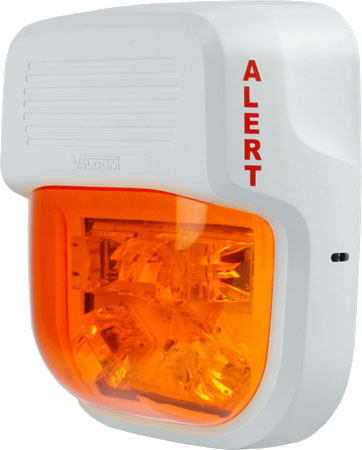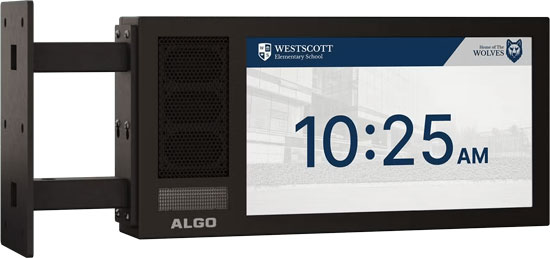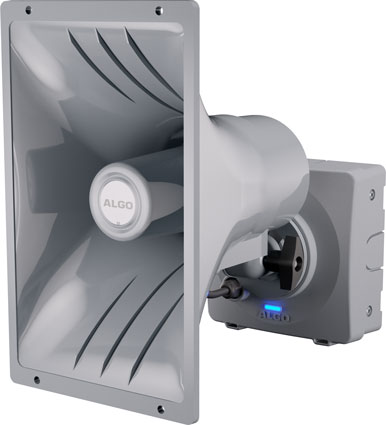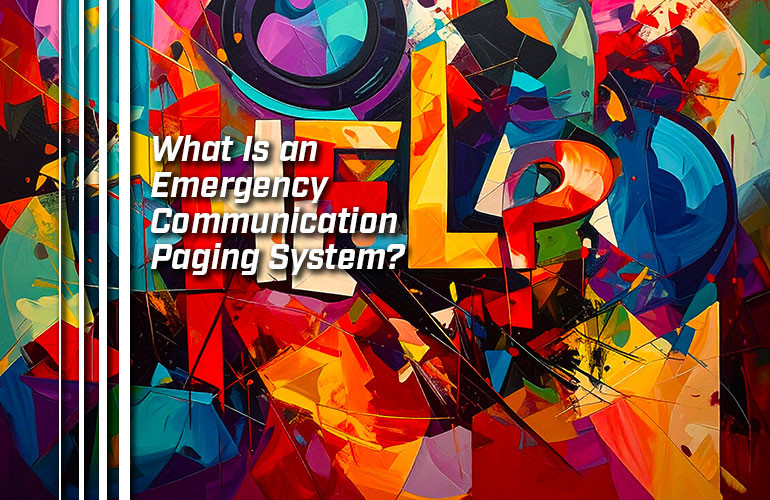Despite the name, paging systems aren’t just for paging. They’re also essential infrastructure in emergency scenarios.
When you need to let many people know critical information quickly, you need a paging system for emergency communications.
Paging systems are also known as public address systems or PA systems, which is what a properly set-up system solves: emergency communication PA systems address the public at the most critical times.
That’s why establishing a professional paging system for emergency situations is so important.
There are several causes of emergencies that demand public broadcasting:
- Weather or environmental disasters
- Mechanical or architectural failures
- Fire
- Chemicals or dangerous substances
- Violent scenarios like active shootings
In this blog, we’re going to introduce emergency communication IP paging systems by looking at a variety of scenarios in which emergency notification broadcasting might happen, focusing on the locations where they might occur.
If you’d like to read about the how rather than the where, check out our blog, “How to Broadcast Emergency Notifications from a Paging System.”
We’re focusing on network-connected IP paging systems and not analog paging systems, because there are many more possibilities with IP paging solutions for emergencies.
As we go along, we’re going to introduce the products to know about, not just paging speakers, but also loud ringers, strobe lights, digital signage, and more.
Let’s get into it!

Paging Solutions for Emergencies
Paging systems are communications solutions for public spaces, the places where many people will be listening. That might be in a park or a factory or a school, but the audio is played publicly.
Emergency paging systems use standard paging and public communications equipment with perhaps an extra device or two like a strobe light for accessibility.
Much of the important work, however, is done by the IP paging platform and software. Because of the wide diversity of options with paging systems, we won’t be able to get into too many specifics beyond telling you about the features to look for in an IP paging system for emergency notifications.
On top of being able to send mass alerts to the public, it also helps to setup a paging system that enables contact with the people in charge of the situation. For example, you want teachers to be able to contact the principal.
What kind of equipment do you need for an emergency communication paging system?
Let’s start with perhaps the most critical location: schools.
Emergency communications paging systems for schools must be simple to operate and accessible. They need to cover a wide range of possibilities, particularly environmental concerns like sudden thunderstorms. Active shooters are an ever-increasing concern, too.
Look for school paging systems that support emergency alerts. You should be able to set a specific alarm tone that you can use in practice scenarios to let everyone know what it sounds like. You should also be able to record alarm messages beforehand, so you can just hit play instead of worrying about speaking. If you have digital signage in your school, you should also be able to display warning or informational messages on those signs, as well.
Depending on your institution’s policies, you should be able to send alerts via the paging system to students’ phones as texts or emails. You might even be able to setup automatic social media alerts or automatically contact the police or fire stations.
One paging solution that many schools use is Singlewire InformaCast, which has this text and email integration. It can activate strobe lights, display digital signage information, and even contact dispatchers. InformaCast is a broadly supported mass notification solution. If you’d like to know more about it, we cover it in more detail in our blog, “Mass Paging with Singlewire InformaCast.”
In terms of equipment beyond the standard paging equipment of speakers, amplifiers, and so on, you might look into panic buttons, which can be set to dial the head office directly. These can be installed on the teachers’ desks where students will be less likely to mess with them.
If you have two-way paging speakers — often called talk-back speakers — the teacher can speak with the head office. Some talk-back paging speakers have microphones built into them and others support a connection with an external microphone.

Another device worth looking into is a strobe light. With schools, accessibility is a key concern. Accessibility makes it easier for everyone. How do you improve the accessibility of emergency communications in a school?
Strobe lights are a key solution. When it comes to this topic, strobes are visual alerters or flashers. We’re not talking about smoke machines at Prom here. They are lights that are attached to the paging system that light up in response to specific events. They can be integrated with a paging speaker or a separate device.
They’re valuable not only for ensuring that hearing-challenged students and personnel are alerted, but also for loud areas like shop. And doubling the noticeability of the emergency notification with bright flashing lights is just a good idea, anyways.
Many strobe lights offer a selection of flashing patterns, which you can customize for a specific pattern. While running practice scenarios, you can set the system to flash the emergency pattern.
If you’d like to know more about strobe lights, check out our blog, “The Many Uses of IP Strobe Lights.”
Another device is found in the category often called digital signage. There are two basic types of digital signage.
One is a TV or HD display that you control via your communications platform. These are really useful, because TVs are comparatively inexpensive and can be very large, and therefore very visible. There are numerous platforms for digital signage, some of can integrate with your paging system. They can display warnings or exit routes.
The other is a device that’s integrated with a paging speaker, like Algo 8410 or Algo 8420. You might see these called display speakers or something like that. These devices will have smaller displays than you can get with a TV, but they provide a unified emergency communications solution. You get a paging speaker and digital signage at the same time. Some of them even have strobe lights integrated for a three-in-one solution.
If you’d like to know more about digital signage, check out our blog, “Integrating Digital Signage with VoIP Paging Systems.”
Many of these emergency paging devices and emergency notification best-practices apply beyond schools.
Let’s look at some more locations.

Retail spaces are places where many people congregate. It sounds a bit funny when put like that, but it’s true: lots of people are together at the same time in a supermarket or in a shopping mall.
The tough fact about emergency communication notification systems is that they force you to think about the worst things that can happen. For example, if a shopping mall is getting long in the tooth, it might be a practical consideration to have a warning system in place in case of architectural failures. Collapsing parking structures, for example, aren’t unheard of and can be very dangerous.
IP paging systems can integrate with IP security cameras. For example, more recent Axis cameras like Axis M4225-LVE have built-in audio sensors, which can detect breaking glass and more. They can then activate an event, which could be an emergency alert broadcast via your paging speakers.
In a retail space like a clothing store, you’ll probably want surveillance cameras to prevent loss of merchandise and vandalism. This same system can be part of an emergency notification system.
Retail spaces don’t need to be indoors. Car dealerships, lumberyards, and garden centers are retail locations where emergency communications are a concern. Weather is the primary concern here.
With outdoor spaces, you’ll want to have a system of paging horn speakers set up. Horn speakers are paging speakers with horns that condense sound to increase the volume per given amount of power. Look for weather-proof horn speakers that are durable for your specific environment: extreme cold, extreme heat, excessive precipitation. You’ll also want strobe lights.
The outdoor emergency paging system also lets sales consultants and customers know what’s happening generally, so your alarm solution for a car dealership is a multi-purpose communications solution.
Related to car dealerships are automotive repair centers or car garages. Emergencies at car garages might be chemical — a dangerous substance is accidentally spilled. You want an ultra-durable alarm button that sets off an alert immediately, which can be integrated with your paging system.
Another public space where an emergency communication paging system comes in useful is in transportation locations like train, bus, or subway stations.
With transportation locations, you’ll want a system of emergency phones for personal protection. A traveler about to be mugged needs to be able to call emergency staff immediately.
Emergency phones are intercoms in brightly colored clothing, which means they often play sound publicly. If an emergency phone is an intercom, it can double as a paging speaker. And if it can double as a paging speaker, it can be used for broadcasting emergency alerts or messages. (Some emergency phones have a handset. These don’t work for public emergency paging.) If you’d like to know more, check out our blog, “What Is an Emergency Phone?”

Outdoor emergency communications are the most challenging locations simply because of the amount of space you need to cover.
Your primary concern with outdoor emergency notifications is environmental: tornadoes, thunderstorms, earthquakes. Violent scenarios are also a major concern.
There are two ways to think about outdoor spaces, what we’ll call controlled vs uncontrolled spaces.
Controlled spaces are zoos, amusement parks, sports fields, swimming pools, gardens, and so on. These spaces have technological infrastructure that allow for paging systems to be setup and run easily. You can even include waste disposal centers in this type of public space.
IP paging systems, by the way, are particularly good at handling outdoor emergency notifications, because integrating a distributed paging system is much, much easier with a VoIP paging system for emergencies rather than an analog system.
Emergency communications paging systems for outdoor public spaces are very similar to the outdoor retail spaces we mentioned earlier. The big concern with these spaces is simply area coverage. You need powerful paging speakers and sirens with bright strobe lights in highly visible areas.
If there’s a tornado warning and a Little League baseball game is in the third inning, you have make sure everyone has time to evacuate.
Uncontrolled spaces are places like public parks. They can also be temporary spaces like parade routes or fireworks display grounds. These types of spaces don’t have good infrastructure for emergency notifications and are the most challenging places of all.
Emergency phone towers are a solution for person protection like that emergency phones we talked about earlier. They can be used for emergency paging.
Many parks have spaces for concerts or beer gardens or swimming change rooms, which can provide a place with the infrastructure necessary.
But if the space doesn’t have the capability to support paging infrastructure, you have to rely on mass notification systems that reach people directly via their phones. And hopefully your city has an outdoor warning siren — those loud wails that are tested at noon every now and then.

